Up until twenty years after the political upheaval of the American Revolution in 1776, the Thirteen Colonies had been using British cookbooks reprinted in America. The first such cookbook was printed in Williamsburg, by William Parks in 1742, titled “The Compleat Housewife.” The book was in fact, a London bestseller, published fifteen years earlier in 1727.
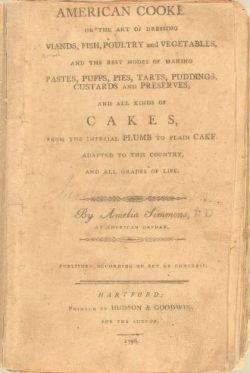 America’s first truly indigenous cookbook, Amelia Simmons’s “American Cookery,” was published in Hartford in 1796. The first edition was published by Hudson & Goodwin of Hartford, CT. The words “For the Author” on the title page suggest that Simmons paid the printing costs herself. It was economically issued without hard covers, thus the title page also served as the front cover. The cookbook was the first to suggest serving cranberry with turkey and introduced the use of a chemical leavening agent, potash, which was precursor to modern baking powder. Potash was a well-known staple in the colonial American household, and its use in baking to cause dough to rise, was a breakthrough in home cooking.
America’s first truly indigenous cookbook, Amelia Simmons’s “American Cookery,” was published in Hartford in 1796. The first edition was published by Hudson & Goodwin of Hartford, CT. The words “For the Author” on the title page suggest that Simmons paid the printing costs herself. It was economically issued without hard covers, thus the title page also served as the front cover. The cookbook was the first to suggest serving cranberry with turkey and introduced the use of a chemical leavening agent, potash, which was precursor to modern baking powder. Potash was a well-known staple in the colonial American household, and its use in baking to cause dough to rise, was a breakthrough in home cooking.
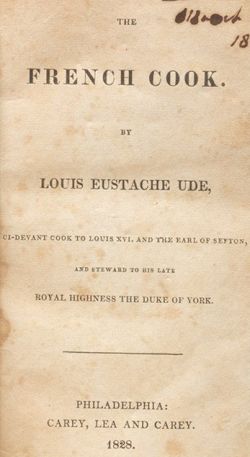 The first French cookbook to be published in America, was appropriately called nothing less than, “The French Cook” by Louis Eustache Ude; an experienced chef, who worked for the Duke of York, (King George III’s second son, Prince Frederick Augustus), and formerly an apprentice sous-chef in Louis XVI’s kitchens maître d’hôtel of Napoleon’s mother, Ude. At the time of the book’s release he was employed in London by William Crockford who run a private gambling house and exerted great influence on high society. In 1828, fifteen years after the original London publication by Cox & Baylis, the book was published in Philadelphia, by Carey Lea & Carey and introduced American families to the delicacy of turtle soup.
The first French cookbook to be published in America, was appropriately called nothing less than, “The French Cook” by Louis Eustache Ude; an experienced chef, who worked for the Duke of York, (King George III’s second son, Prince Frederick Augustus), and formerly an apprentice sous-chef in Louis XVI’s kitchens maître d’hôtel of Napoleon’s mother, Ude. At the time of the book’s release he was employed in London by William Crockford who run a private gambling house and exerted great influence on high society. In 1828, fifteen years after the original London publication by Cox & Baylis, the book was published in Philadelphia, by Carey Lea & Carey and introduced American families to the delicacy of turtle soup.
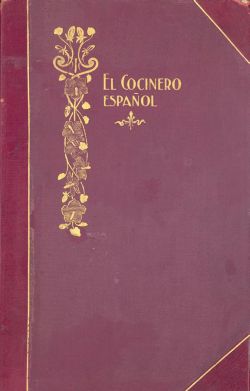 The first Mexican-American cookbook was also the first cookbook written by a Hispanic in the United States and the first recording of Californio food. “El cocinero español” by Encarnación Pinedo was published in San Francisco in 1898. It offers a fascinating look of the cuisine of early California, which was largely forgotten in the wake of Anglo appropriation and subsequent waves of Mexican migration. The book was written in Spanish, and featured mainly Mexican, Spanish, and Basque ingredients such as the fruit of the barrel cactus and recipes like the salsa picante de chile Colorado, which is precisely how it is still made from the Rio Grande to California.
The first Mexican-American cookbook was also the first cookbook written by a Hispanic in the United States and the first recording of Californio food. “El cocinero español” by Encarnación Pinedo was published in San Francisco in 1898. It offers a fascinating look of the cuisine of early California, which was largely forgotten in the wake of Anglo appropriation and subsequent waves of Mexican migration. The book was written in Spanish, and featured mainly Mexican, Spanish, and Basque ingredients such as the fruit of the barrel cactus and recipes like the salsa picante de chile Colorado, which is precisely how it is still made from the Rio Grande to California.
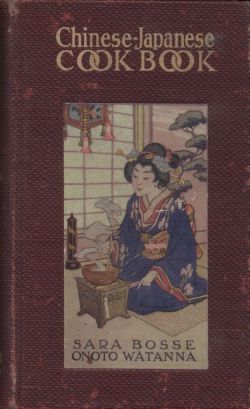 Despite the fact that Chinese food stems from one of the world’s oldest and most sophisticated cuisines, and that it’s been in the U.S. for more than 160 years, it largely remained unpublished in America until the early 20th century. Available in America after the Civil War, into the 1920’s, “Chinese-Japanese Cook Book”, by Sara Bosse and Onoto Watanna [pseud.], Chicago, Rand McNally [c1914], is one of the earliest half-dozen Chinese cookbooks published in the United States; and possibly the first Japanese one. Authentic Chinese dishes for Americans in that era, such as Bird’s-nest Soup, Seaweed Soup, Sweet and
Despite the fact that Chinese food stems from one of the world’s oldest and most sophisticated cuisines, and that it’s been in the U.S. for more than 160 years, it largely remained unpublished in America until the early 20th century. Available in America after the Civil War, into the 1920’s, “Chinese-Japanese Cook Book”, by Sara Bosse and Onoto Watanna [pseud.], Chicago, Rand McNally [c1914], is one of the earliest half-dozen Chinese cookbooks published in the United States; and possibly the first Japanese one. Authentic Chinese dishes for Americans in that era, such as Bird’s-nest Soup, Seaweed Soup, Sweet and 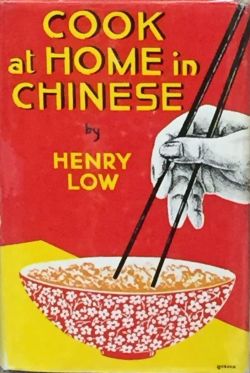 Sour Fish, Steamed Duck, Chop Suey, Chow Main, and Fried Rice are combined with a shorter section of Japanese dishes which include Satsuma Soup (using tofu and miso paste), Hare, Sweet and Sour, Usagi Amai-Sui, and Peony Eggs. Americanized Chinese recipes were popularized by Henry Low, head chef at the Port Arthur Chinese Restaurant in New York City, and author of “Cook at Home in Chinese, New York by Macmillan [1938]. He is credited to have invented the Egg Roll “Tchun Guen;” the recipe is found in this book on page 213.
Sour Fish, Steamed Duck, Chop Suey, Chow Main, and Fried Rice are combined with a shorter section of Japanese dishes which include Satsuma Soup (using tofu and miso paste), Hare, Sweet and Sour, Usagi Amai-Sui, and Peony Eggs. Americanized Chinese recipes were popularized by Henry Low, head chef at the Port Arthur Chinese Restaurant in New York City, and author of “Cook at Home in Chinese, New York by Macmillan [1938]. He is credited to have invented the Egg Roll “Tchun Guen;” the recipe is found in this book on page 213.
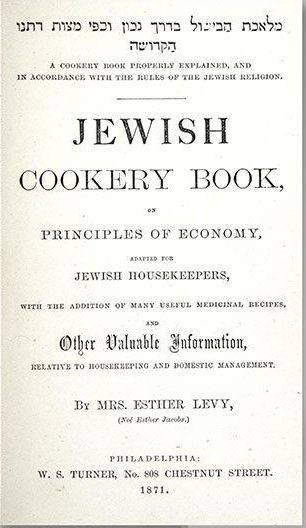 The first Jewish cookbook published in America, was published by W.S. Turner in Philadelphia, in 1871. The “Jewish Cookery Book, on Principles of Economy, Adapted for Jewish Housekeepers, with the Addition of Many Useful Medicinal Recipes, and Other Valuable Information, Relative to Housekeeping and Domestic Management” by Esther Levy, carried extensive instructions on keeping a kosher household. It also guided Jewish women of the period, to serve meals with panache and maintain elegant yet kosher homes. The large selection of recipes such as “To Make Stewed Fish Balls” and exotic “Calf’s Brain and Pigeon, Stewed with Green Peas,” are presented with basic laws associated with a kosher home including the soaking and salting of meat.
The first Jewish cookbook published in America, was published by W.S. Turner in Philadelphia, in 1871. The “Jewish Cookery Book, on Principles of Economy, Adapted for Jewish Housekeepers, with the Addition of Many Useful Medicinal Recipes, and Other Valuable Information, Relative to Housekeeping and Domestic Management” by Esther Levy, carried extensive instructions on keeping a kosher household. It also guided Jewish women of the period, to serve meals with panache and maintain elegant yet kosher homes. The large selection of recipes such as “To Make Stewed Fish Balls” and exotic “Calf’s Brain and Pigeon, Stewed with Green Peas,” are presented with basic laws associated with a kosher home including the soaking and salting of meat.
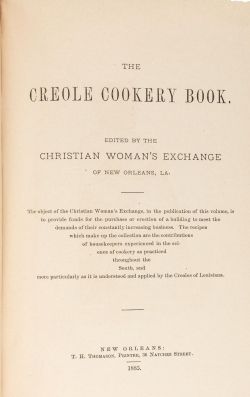 A landmark culinary work; the first cookbook of Creole cookery, and the first New Orleans recipe collection, “The Creole Cookery Book” by the Christian Woman’s Exchange of New Orleans, LA., was published by T.H. Thomason in 1885. Recipes were collected from housekeepers experienced in the science of cookery as practiced throughout the South, and more particularly as it is understood and applied by the Creoles of Louisiana. The classic New Orleans text includes recipes for Green Gumbo, Epicurean Oysters, and Jambalaya
A landmark culinary work; the first cookbook of Creole cookery, and the first New Orleans recipe collection, “The Creole Cookery Book” by the Christian Woman’s Exchange of New Orleans, LA., was published by T.H. Thomason in 1885. Recipes were collected from housekeepers experienced in the science of cookery as practiced throughout the South, and more particularly as it is understood and applied by the Creoles of Louisiana. The classic New Orleans text includes recipes for Green Gumbo, Epicurean Oysters, and Jambalaya 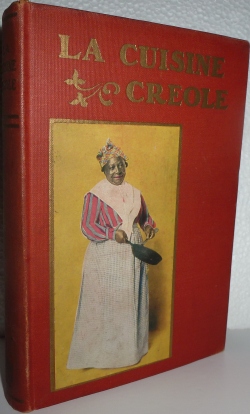 among others. Together with another fine New Orleans cookbook: “La Cuisine Creole: A Collection of Culinary Recipes, From Leading Chefs and Noted Creole Housewives, Who Have Made New Orleans Famous for its Cuisine,” by Lafcadio Hearn, New Orleans: F.F. Hansell & Bro., Ltd. [1885], offer the introduction to Creole cooking, one of America’s most unique cuisines.
among others. Together with another fine New Orleans cookbook: “La Cuisine Creole: A Collection of Culinary Recipes, From Leading Chefs and Noted Creole Housewives, Who Have Made New Orleans Famous for its Cuisine,” by Lafcadio Hearn, New Orleans: F.F. Hansell & Bro., Ltd. [1885], offer the introduction to Creole cooking, one of America’s most unique cuisines.
Pellegrino Artusi was the first Italian cookbook author to be published in Italian in America. His book “La scienza in cucina e l’arte di mangiar bene” (Science in the Kitchen and the Art of Eating Well), filled with amusing anecdotes as well as recipes, was self-published in 1891, when Artusi was 71 years old. However, no one has ever done more to spread the gospel of pure Italian cookery in America than Maria Gentile. 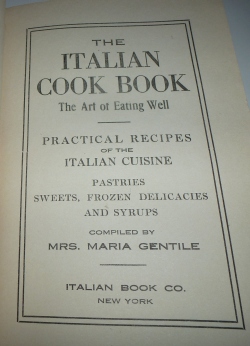 She compiled a cookbook by the name “The Italian Cook Book: The Art of Eating Well, Practical Recipes of the Italian Cuisine, Pastries, Sweets, Frozen Delicacies, And Syrups,” New York: Italian Cook Book Co., [1919]. The book was conceived to present Italian food, not pretentious but Casalinga [homemade]. The Preface begins with the statement that, “One of the beneficial results of the Great War [WWI] has been the teaching of thrift to the American housewife. For patriotic reasons and for reasons of economy, more attention has been bestowed upon the preparing and cooking of food that is to be at once palatable, nourishing and economical.” There are modern and sophisticated recipes for artichokes, zucchini, risotto, macaroni, polenta, eggplant, gelati, gnocchi and zabaione.
She compiled a cookbook by the name “The Italian Cook Book: The Art of Eating Well, Practical Recipes of the Italian Cuisine, Pastries, Sweets, Frozen Delicacies, And Syrups,” New York: Italian Cook Book Co., [1919]. The book was conceived to present Italian food, not pretentious but Casalinga [homemade]. The Preface begins with the statement that, “One of the beneficial results of the Great War [WWI] has been the teaching of thrift to the American housewife. For patriotic reasons and for reasons of economy, more attention has been bestowed upon the preparing and cooking of food that is to be at once palatable, nourishing and economical.” There are modern and sophisticated recipes for artichokes, zucchini, risotto, macaroni, polenta, eggplant, gelati, gnocchi and zabaione.
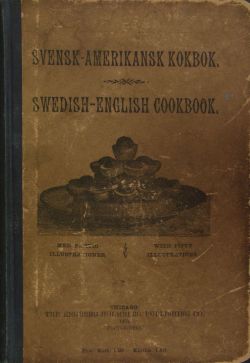 Immigrants from the Scandinavian countries – Sweden, Norway, Denmark and Finland had their original, European language cook books during their early American settlement. A small number of first editions, which were bi-lingual such as the “Fullständigaste Svensk-Amerikansk Kokbok = Swedish English Cookbook,” Chicago: Engberg-Holmberg; 1897 made their appearance. The recipes are written side by side in Swedish and English – and they cover both cultures. From America we have, among others, Boston Brown Bread, Johnny Cakes, Rye and Indian Bread, California Cake, To Smoke Ham in the American Way, Boston Baked Beans, Potatoes Kentucky Style, and several different recipes for Corn Bread. From Sweden we find Pork Chops-Swedish Way, Goose with Horse Radish, Herring Pudding, Swedish Caviar, Pickled Salmon (Graflax), and two Cherry Soups, one made with fresh cherries and one with dried.
Immigrants from the Scandinavian countries – Sweden, Norway, Denmark and Finland had their original, European language cook books during their early American settlement. A small number of first editions, which were bi-lingual such as the “Fullständigaste Svensk-Amerikansk Kokbok = Swedish English Cookbook,” Chicago: Engberg-Holmberg; 1897 made their appearance. The recipes are written side by side in Swedish and English – and they cover both cultures. From America we have, among others, Boston Brown Bread, Johnny Cakes, Rye and Indian Bread, California Cake, To Smoke Ham in the American Way, Boston Baked Beans, Potatoes Kentucky Style, and several different recipes for Corn Bread. From Sweden we find Pork Chops-Swedish Way, Goose with Horse Radish, Herring Pudding, Swedish Caviar, Pickled Salmon (Graflax), and two Cherry Soups, one made with fresh cherries and one with dried.
Noticeably absent from the late 19th early 20th century selection of Ethnic-American cookbooks, is Greece. Despite the popularity of Greek food in America today, it was not until 1942 that the first Greek cookbook: “And the Greeks: A Book of Hellenistic Recipes and Culinary Lore” by MacDougall, Allan Ross was published by the Near East Foundation (NEF) in New York. The NEF was founded in 1915 by the U.S. government to act as a conduit for private American philanthropy assisting Armenian and other refugees during World War I. This first collection of ancient and modern Greek recipes had all profits from the sale used to feed hungry children in Greece during World War II.
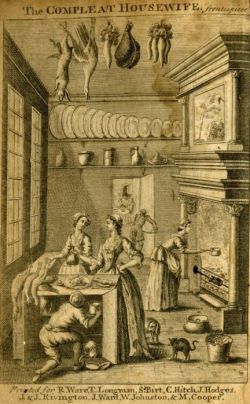
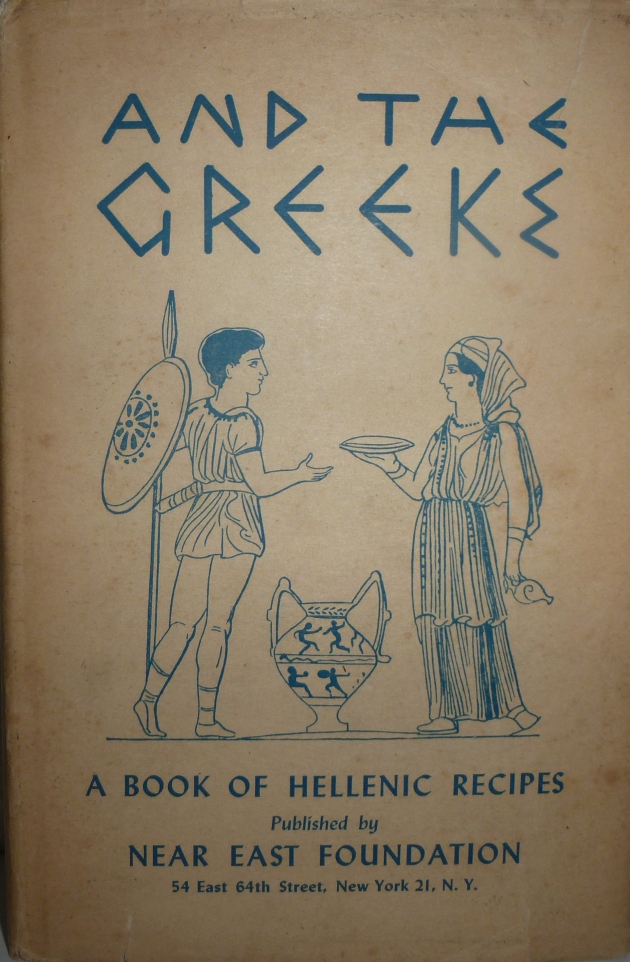

{ 0 comments… add one now }